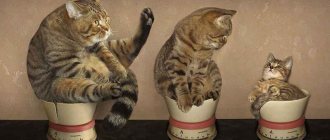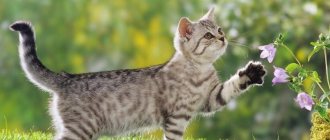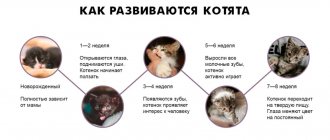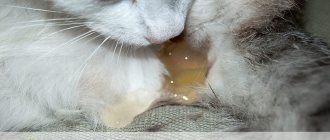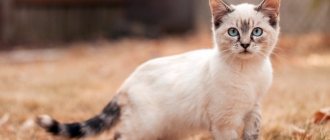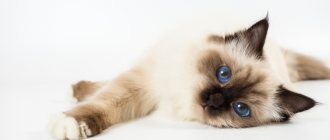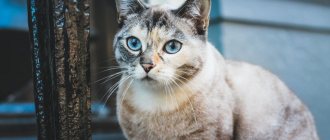If a long-awaited kitten adopted from a breeder appears in the house, the question of its age does not even arise, because the day of its birth is precisely indicated in the passport. It is somewhat more difficult with kittens purchased at the poultry market, because an error of a couple of weeks is possible. What to do if your heart trembles at the sight of a street stray and you are ready to shelter such a cat? How to determine the age of a cat if it comes to you no longer as a cute kitten? This is not an idle interest, but a matter of the health of the cat and all households. Certain diseases or behavioral changes in cats occur at specific ages, so it is necessary to prepare for them. A phenologist can easily determine the age of an animal, but it is not always possible to contact him, so we will try to learn how to do this at least approximately.
TO find out the age, you need to carefully and slowly examine the pet
DETERMINING THE AGE OF A CAT BY TEETH
Determining the age of a cat by its teeth is quite simple.
First, the color of the teeth changes, then there is slight abrasion of the incisors on the lower jaw, then on the upper. The last ones to fall out are the fangs.
Below is the condition of the teeth and the age of the cat:
- - all molars are white and look strong - the cat is 6 months to 1 year old;
- - there is some yellowing on the teeth - the cat is just over a year old;
- — on the lower jaw of the animal there is slight abrasion of the central incisors — the cat’s age is 1.5-2 years;
- — on the lower jaw there is slight abrasion of the middle incisors — the cat’s age is 2 years;
- — tartar has appeared on the teeth – the cat is just over 2 years old;
- — abrasion of the central incisors is noticeable on the upper jaw; the cat is 3-3.5 years old;
- — there is abrasion of the middle incisors on the upper jaw; the cat is 4-4.5 years old;
- - noticeable wear of the fangs - the cat’s age is 5-5.5 years;
- - wear of the outer incisors is noticeable on the upper jaw - age - 5.5-6.5 years;
- — there is abrasion of the central incisors on the lower jaw; the cat is 7-7.5 years old;
- - abrasion of the middle incisors on the lower jaw - age - 7.5-8 years;
- - on the upper jaw there is significant abrasion of the central incisors - 8.5-9 years;
- — there is significant wear on the middle incisors on the upper jaw; the cat’s age is 9.5-10 years.
As a rule, from the age of 10, cats begin to gradually lose teeth:
- — if the lower incisors have fallen out on the cat’s lower jaw — the cat’s age is 10 years;
- — the middle incisors on the lower jaw have fallen out — the cat’s age is 11 years;
- — central incisors fell out on the upper jaw — age — 12 years;
- — the middle incisors fell out on the upper jaw — age — 13 years;
- — loss of all incisors begins from 12 to 14 years;
- - tooth loss begins between 14 and 15 years of age.
Determining the age of the kitten
At 1 month, kittens erupt their first milk teeth.
At 5-6 months, baby teeth are replaced by molars.
External inspection method
The simplest method is considered to be the external examination of the kitten.
In this way, it will be possible to determine the age approximately, because the height, weight and size of the cat depends on many factors and sometimes gives unreliable information about how many months the individual is.
And the older the kitten, the more difficult it is not to make a mistake when determining its age using this method.
Still, it's worth starting with.
- The first thing you need to do is examine the kitten's belly. If an umbilical cord is found there, it means it is a newborn, one to three days old. It is during this time that the umbilical cord heals, gradually dries, and then falls off.
- Closed eyes also indicate recent birth. For the first six months, kittens' eyes are closed. Of course, there are cases when they open after 7 days, but not earlier. Therefore, if they are tightly closed, then it is almost certainly the first week of the baby’s life. But by the end of the second, his eyes will open completely and the kitten will be able to see the world around him. Also, the color of the eyes indicates such a young age. In all kittens it is blue at first, with varying degrees of brightness. But within a month or a month and a half he will begin to change.
- It is worth carefully examining the animal's ears. From birth to 6-8 days of life, they are pressed quite tightly to the kitten’s head. And all because the ear canals are still closed and open gradually, even a little longer than the baby’s eyes. Moreover, the ears themselves do not straighten immediately after the opening of the canals, but after a few weeks. A kitten that is already more than three weeks old has fully straightened ears.
- And now about how to determine the age of a kitten also by its teeth, which is also part of the external examination of the pet. From birth to half a month they are simply absent. But by the end of the second week of life, the first teeth begin to erupt. You can feel them by carefully examining your pet's gums. In the third and fourth week, the kitten begins to acquire its first fangs. By four months, the kitten has a full set of small baby teeth, one in number. If all the teeth have already been replaced by molars, which are larger and stronger, then the pet is at least seven months old.
- Another sign taken into account during external examination is the weight of the animal. The main thing is to remember the developmental characteristics of individuals of the breed to which the kitten belongs, because the weight of individuals of different breeds of the same age differs, sometimes quite significantly. A healthy newborn kitten, up to a week old, weighs on average up to 150 grams. By three weeks the indicator reaches 00-250 g. Then the weight gain increases significantly and by two months it can reach from 600 to 900 grams.
After three months of age, a weight gain of at least 500 grams is considered normal. This happens until the adult cat gains up to 4.5 kg, and the cat gains up to 4 kg. Then the weight gain stops and it can be determined that the cat is at least one and a half years old.
With an external examination, you can quite accurately determine the age of a kitten up to three months. Then the error turns out to be larger.
DETERMINING THE AGE OF A CAT BY EYES
Determining the age of a cat by looking at its eyes can only give an approximate result.
A young animal, as a rule, has transparent, perky, inquisitive eyes
, in which interest and mischief sparkle. Over time, gradual clouding of the eye lens occurs, which is a sign of deteriorating vision and the possible appearance of cataracts.
Iris brightness
The eyes are also an indicator of the cat's age. If the iris has any spots, there is an asymmetrical pattern on it, or it is cloudy in structure, then this indicates that the cat has long passed its “tender” age.
Ears
The appearance of the ears helps in determining the pet's date of birth. Ear age is determined according to the following external criteria:
- Ears that fit tightly to the skull in kittens that are less than a week old;
- the ear canals open 5-6 days after birth;
- Kittens have fully expanded ears after the third week of life.
The ear canals open before the ears themselves straighten. Fully straightened ears indicate that three weeks have passed since the mother cat lambed.
DETERMINING THE AGE OF A CAT BY HAIR
You can find out the approximate age of a cat by its fur.
Typically, young animals have smooth, soft and thick fur. Cats up to 4-5 years old can boast of this “dignity”.
The fur of older cats is less shiny, it is not as thick and elastic. As a rule, a cat at the age of 7 already has gray hairs.
Older animals have dull coats and their fur is brittle rather than elastic. In older long-haired cats, mats in the fur are common because... the animal no longer pays attention to its appearance.
Cat behavior
You can also find out the age of a cat by its activity. The influence of age affects not only the appearance of a pet, but also its habits. Young cats that have just begun their life journey are inquisitive and playful, they are interested in everything new. Middle-aged cats already have life experience; they still show interest in everything new, but they are very cautious and have established habits. Older cats are also not devoid of interest in the world around them, but they can no longer actively move and sleep more often than they are awake.
As cats age, they often begin to show aggression towards strangers; this is associated with increased anxiety and fearfulness. Also, older cats often suffer from a number of chronic diseases, which worsens their well-being, and communicating with a curious stranger does not seem to be the best idea for them against the background of general malaise.
DETERMINING AGE BY BODY STRUCTURE
Over time, the cat gradually loses its activity. It is quite natural that a decrease in physical activity has a direct impact on changes in the animal’s body structure. Thus, young cats are very active and this is characterized by their muscularity and healthy thinness.
Cats aged 3-7 years are already more rounded and well-fed. They are less active and “economical” in their movements.
Older cats have prominent shoulder bones and tend to have loose skin.
Features of age periods
Animals develop much faster than humans. The infant period of a small individual is only a few weeks. If a child’s first teeth appear after 6 months, then a kitten’s teeth will erupt much earlier, at approximately 2-3 weeks. They begin to actively run and explore the interesting world from the age of 1 month. Then, like a human child, he walks confidently after one year.
© instagram.com/juliaolimpian
Infancy and adolescence
The 3-month-old animal plays briskly with its brothers and owner and recognizes its own. Imitating his mother, he begins to groom himself, wash himself, brush his fur, and copy the behavior of his older brothers. He easily finds his bowl, bed and tray.
In a short period of time of 2-3 months, pets, by human standards, become several years older. Thus, a three-month-old kitten is developmentally equivalent to a three-year-old baby. And by the age of six months, he is developed like a fifteen-year-old teenager. The method of age transfer helps to understand why it is so important in this short period to give maximum importance to raising a small pet.
It is during this period that the main character traits, skills, and bad habits are formed. Inexperienced owners often forgive his pranks and disobedience in the hope that this will pass over time. At this moment, it is important to learn to be firm and promptly stop disobedience. After all, by 6 months the animal has a fully developed character, which will be difficult to correct.
Puberty in pets occurs between 5 and 7 months. The first heat may appear and even pregnancy may occur. However, the body is still too young and this is not the most favorable period for mating. The body must be fully formed.
Features of psychological and physical factors in the development of a one-year-old animal are comparable to the development of an adult human.
Having matured and become more serious, the pet still often continues to play and hide. And the cat becomes more graceful and even predatory
The speed of development depends on several factors, including the breed. Individuals of eastern breeds develop somewhat earlier and by one year they are, as a rule, fully developed. And larger breeds complete development only closer to 2 years.
Maturity
On average, the flowering of youth in animals begins at the age of one and a half years. This is 20 years old for a cat by human standards. The period lasts about six years. And it ends at 40 years of relative age of cats by human standards. During this period, the animal is distinguished by special energy, strength and endurance.
. Also, this is the most favorable period for exhibitions and breeding of high-quality offspring. For purebred individuals, the ideal period for motherhood ends by the age of seven. In order to maintain the animal’s good health after this period, it is worth following the recommendations of specialists:
- timely sterilization improves the health and energy of the animal;
- optimal weight, measures to prevent obesity will help him live longer;
- Sincere love and attention to your furry friend also contributes to good health and longevity.
Maturity and old age
The mature age of a cat by human standards occurs at seven years, i.e., at the age of 50 for a person. The animal can still be playful, but generally it behaves more calmly. Activity during this period largely depends on the breed and living conditions. There are some breeds that retain their playful character into old age.
But, unfortunately, the matured body begins to malfunction in some systems. Sometimes signs of chronic diseases appear.
If the animal was not sterilized in a timely manner, then it is worried about hormonal imbalances.
In cats, age is considered old at 12 years. Living conditions and genetics play a big role in the life expectancy of an animal. Outdoor individuals that have endured hardships and bad weather rarely live longer than 10 years. And pets often live up to 20 years, which in human terms reaches a hundred years. Of course, in order to prolong the life of a beloved friend, he will need special care and the absence of stressful situations.
Particular attention should be paid to the diet of an elderly animal. Large amounts of salt, protein and phosphorus can lead to kidney or heart failure. Food should contain the necessary vitamins and microelements, but at the same time be less caloric.
OTHER SIGNS OF DETERMINING THE AGE OF A CAT
In addition, the approximate age of a cat can be determined by the pads on its paws.
:
- - if they are pink and smooth, the cat is still young enough,
- - if there are cracks and pads on the paws and they are worn out, then the cat is already in adulthood.
Don't forget to check the claws
:
- - In older cats, the claws may be fragile and broken off in some places. In young individuals, the claws are usually very strong.
Also pay attention to how long your cat sleeps.
. If your purr sleeps a lot, chooses between playing and a warm bed, the second option, then it is quite possible that your cat is already an old lady.
Useful tips
A baby’s memory works best when remembering from two to seven weeks. This period is the best for socialization.
If the pet quickly overcomes fear and willingly goes into your arms, then most likely it is no more than two months old.
It is necessary to actively accustom the kitten to holding hands, talk to it affectionately, and play a lot. But even if the pet is clearly older and continues to run wild, do not despair, love and patience can break the stereotype of a cat’s behavior, no matter what age he is.
If the gender of the kitten is unknown, then it is quite easy to determine it from the age of two weeks. The male's genitals resemble a colon, while the female's have a question mark.
As they grow older, secondary sexual characteristics (size, weight, build) become more obvious.
HOW OLD IS A CAT BY HUMAN STANDARDS?
The average lifespan of cats is 13-15 years. However, many of us are interested in how old a cat is by human standards. There is no standard formula for determining the ratio of the age of a person and a cat, but there are approximate data that allow us to answer this question.
So, the age of a cat “increases” in inverse proportion to the age of a person. But it is also important not to forget that the lifespan of a cat depends on the conditions of its keeping and on its belonging to a particular breed.
- - cat 1 year old - human 15 years old
- - cat is 2 years old - human is 23 years old
- - cat is 3 years old - human is 27 years old
- - cat is 4 years old - human is 32 years old
- - cat 5 years old - human 35 years old
etc.
The oldest cat can be probably 23-25 years old. This age corresponds to 100 years in humans.
Definition of puberty
When a pet comes into a person’s house at an unknown age and it was not possible to calculate it based on its teeth, size and weight, it is enough to wait for the first signs of puberty.
In almost all breeds, females are ready for fertilization by ten to twelve months, and the first heat can occur between six and eight months.
A male can feel the first signs of rutting at about the same age, but some cats remain indifferent to the opposite sex for up to a year or a year and a half.
Both male and female cats can begin to actively mark their territory during puberty.
Typically, purebred kittens reach sexual maturity later than their domestic counterparts.
But the first signs of approaching maturity can be noticed in a pet from four to five months, as hormonal changes in the body begin. This manifests itself in active sniffing of an animal of the opposite sex, and signs of some irritability and aggression appear.
Males can start fighting, dividing territory and females as early as six months. Therefore, you need to behave especially carefully with such teenagers.
HOW MANY YEARS DO DOMESTIC CATS LIVE?
The lifespan of domestic cats depends on many factors.
Firstly, it belongs to a certain breed. For example, representatives of less “elite” breeds are longer-livers than their “aristocratic” counterparts.
Secondly, their sexual activity plays a huge role in the lifespan of domestic cats. If a domestic cat (cat) does not have the opportunity to have an active sex life, then the excess of their unrealized hormones has a negative impact on their lifespan.
- The third factor is heredity.
- The fourth factor is lifestyle.
- The fifth factor is diet.
- The sixth factor is the emotional state of the animal.
- The seventh factor is the level of disease resistance.
Considering all the above factors, it is not entirely correct to talk about the life expectancy of domestic cats. Theoretically, a healthy cat under ideal conditions can live up to 25 years, but this is more the exception than the rule.
Kitten sizes
The size of a kitten is influenced by the breed of its parents. Newborn kittens are placed in the palm of your hand; depending on the breed, the length of the body varies from 7 to 12 cm. The head is disproportionately large; the tail is not taken into account when measuring. Each subsequent month of life, the baby gains from three to six centimeters. At the age of six months, the young individual reaches a length of 20-25 cm. Males grow faster; monthly males gain 1.5-2 cm more in height than females. Kittens of different sexes from the same litter can be very different.
